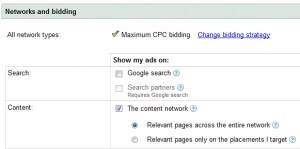Historically, Google AdWords’ Content Network has gotten a bad rap. And for good reason.
Advertisers usually see much lower ROI results from it than from the Google Search and Search Partner networks.
And it’s easy to suspect, when they recommend the Content network, that Google just wants clicks – for the revenue and to maintain control over a large piece of internet ad space.
I now have reason to believe that the poor results are because most people do the Content Network wrong. And we have a new approach from Google themselves, which I’ll detail below.
How People Screw Up Their Content Network Campaigns
The most overlooked aspect of Content Network campaigns is the fact that keywords must be chosen in a completely different fashion from Search networks.
Because of this, it’s folly to run any one campaign in BOTH content and search networks. You must separate content campaigns from search campaigns. If you run both, any one ad group will be setup for success in content or search, but not both. Like the song says, “you gotta keep ‘em separated.”

Create Keyword Themes
Unlike search campaigns, where each keyword creates the opportunity for an ad to be triggered by a user search query, content network ads are placed on websites relevant to the theme you create with the keywords in your ad group. There’s an art to this keyword theming.
In fact, it’s such an art that Google’s own optimization specialists meet to talk and compare notes about what does and doesn’t work.
I found this out recently when one of our dedicated AdWords reps started pushing the Content Network. The conversation led me to ask, “So you’re saying, your AdWords system is so complicated, you guys have to figure it out too?” He said, “Yes.”
If you read the AdWords Help on Content Network success, you get the gist of keyword theming.
Base Keyword in Every Keyword for Better Targeting
But something that may or may not be completely clear – something he told me they learned recently – is that if you want to target more specifically, to ensure your ads are targeted and you get the best ROI, you need to include the base keyword in every content network keyword.
What do I mean by base keyword? If you want to geotarget Boca Raton by search query, put “Boca Raton” in every keyword. If you want to target “fantasy football”, make sure “fantasy football” is in EVERY keyword.
Then you can create similar but targeted content ad groups, and mixes. For example:
- You could build a general ‘Beach Hotels’ ad group that would look like this:
beach hotel, beach hotels, ocean beach hotels, hotels on the beach, luxury beach hotels, beachfront hotels, beachfront hotels, best beach hotels, beachfront hotel packages, beach front hotels
- You could then build a general ‘Beach Resorts’ ad group:
beach resorts, beach resort, beachfront resorts, resorts on the beach, luxury beach resorts, beachfront resorts, ocean beach resorts, beach resort packages
- And then you can create a mixed ‘Beach Hotels and Resorts’ ad group:
beach resorts, beach hotels, beach hotels and resorts, resorts on the beach, luxury beach hotels, resort beach packages, beach hotel rooms, beach resort rooms, beach resorts
As usual, add negative keywords, exclude sites, see how each does, and pause underperforming ad groups.
All that aside, if your goal is broader reach and more traffic, make the keywords more diverse, and do not use this base keyword every time strategy.
Overlapping Themes: Reach and Targeting
The mixed group above raises the questions: How does the system decide where to show ads when you overlap content groups? Does that cause the ads to go to the more targeted of the sites? Or get shared amongst them? Or does that overlap not really affect where they show?
Here’s what our AdWords rep had to say about that:
So when the ad groups overlap a bit, think of it as Venn diagram with three circles that are nearly overlapping. This allows for the largest ‘area’ covered (your Content reach), but it also allows for the ad placement to be most targeted. There will be some sites that only one ad group matches to, some sites that the other ad group is eligible for, and so on. For example, some websites may distinctly have more of ‘hotel’ theme than a ‘resort’ theme, leading one ad group to get placement over another (making it more targeted).

When the ad groups are very close to each other though, there is bound to be some overlap between the different ad groups. In that situation, what is going to happen is that as you accrue more and more data, our system will ‘learn’ which ad group performs the best on a specific site. Part of the ad delivery system and the Quality Score on the Content network is the performance of an ad and ad group on a specific site (and similar sites). If one ad group is outperforming the others on a consistent basis for a specific site (based on CTR), it will start accruing most of the impressions for that site. Based on budgets, ad delivery spacing, and other variables, it probably won’t receive 100% of the impressions for that site, but could receive a majority of them.
Keyword Theming ROI Results
We have two Content ad groups right now that are getting exceptional results. The first is getting an 1100% ROAS. The second is getting a 500% ROAS.
Both are getting much better ROI than I’ve come to expect from the Content Network, so we’re deploying more across our client accounts.
Brian Carter is the Director of Search Engine Marketing for Fuel Interactive, an interactive marketing agency in Myrtle Beach, South Carolina. He is responsible for the SEO, PPC, SMM, and ORM programs at Fuel and its partner traditional agency Brandon Advertising & PR.





![[SEO, PPC & Attribution] Unlocking The Power Of Offline Marketing In A Digital World](https://www.searchenginejournal.com/wp-content/uploads/2025/03/sidebar1x-534.png)